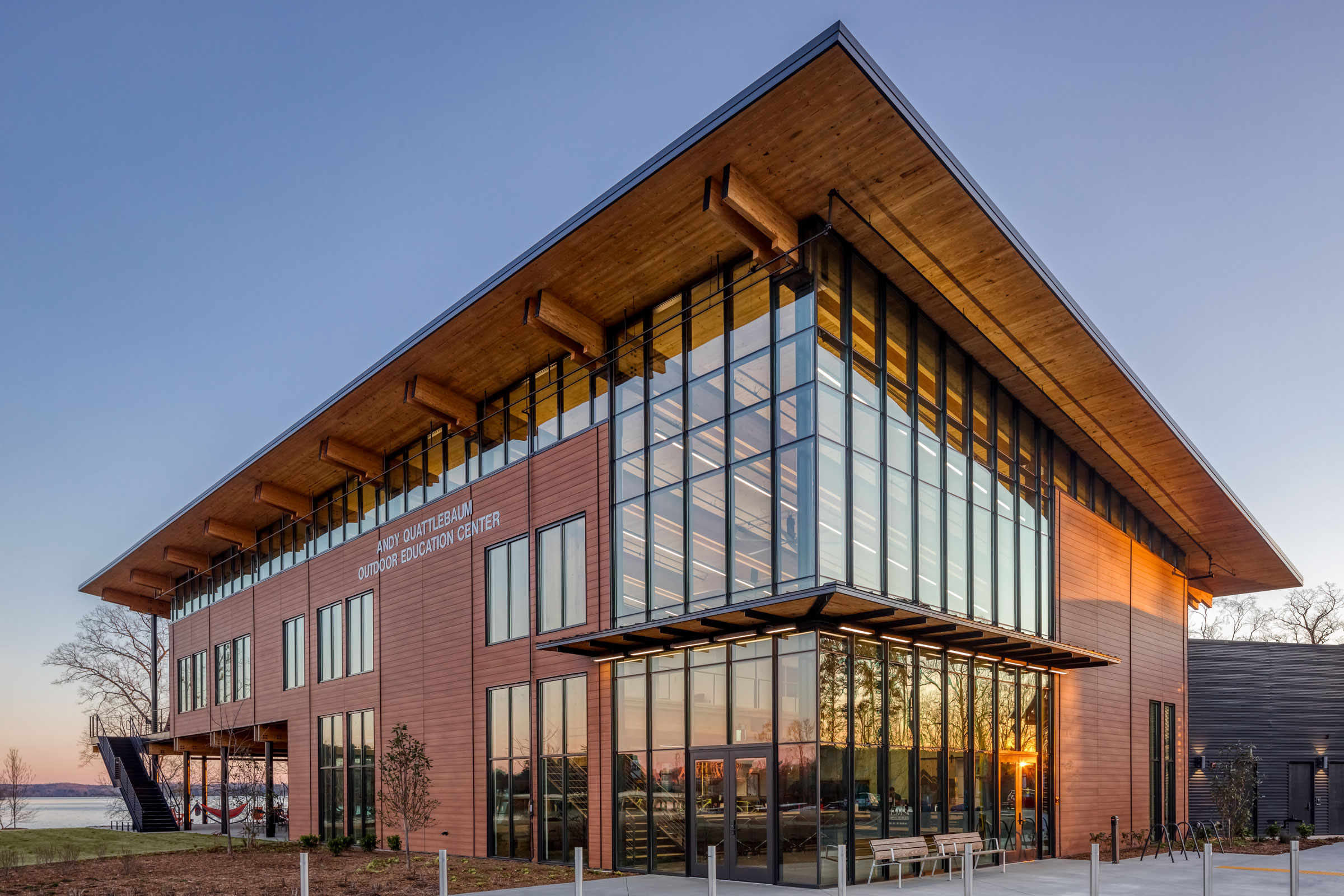Story at a glance:
- Cross-laminated timber (CLT) is a mass timber product that serves as a sustainable and lighter substitute for steel and concrete.
- In London, Dalston Works is built almost entirely of CLT, reducing construction waste by an estimated 80%.
- Exposed CLT on the exterior of the building 69 A Street creates a much warmer exterior than standard steel.
These examples of cross-laminated timber (CLT) architecture show why CLT is an up-and-coming replacement for heavier materials like steel and concrete.
Cement and concrete manufacturing is responsible for around 8% of global greenhouse gas emissions—more than any country except the US and China. The iron and steel industry are responsible for another 5%, according to a report by the Netherlands Environmental Assessment Agency. To lessen a building’s carbon footprint, architects may try swapping concrete or steel for CLT.
Here is a list of projects that use cross-laminated timber.
What is Cross-Laminated Timber?

Cross laminated timber is a strong, lightweight, and sustainable building material. Photo courtesy of Oregon Forest Resources Institute
Cross-laminated timber, or CLT, is a category of mass timber that is made by laying multiple layers—typically an odd number—of boards perpendicular to one another and then bonding them together using structural adhesive. The alternating fibers make CLT an extremely strong material with a high compression strength, despite being much lighter than conventional structural materials like concrete or steel.
As long as the timber used to manufacture CLT is harvested from ethically managed forests, it is considered to be a sustainable building material. This is because trees absorb carbon as they grow and sequester said carbon until they begin to decompose, preventing it from entering the atmosphere. In fact, one cubic meter of CLT is capable of storing an estimated 1.10 tons of carbon dioxide, according to a study published by the Journal of Cleaner Production.
20 Examples of Cross-Laminated Timber Architecture
1. Aveiro Park House, Aveiro, Portugal

Paulo Martins Arquitectura & Design designed a striking modern home on a narrow urban lot using CLT. Photo by Ivo Tavares
Designed by Paolo Martins Arquitectura & Design, the Aveiro Park House is one of the first projects in the country to use CLT. All of the mass timber used in the home’s construction was imported from Austria, arriving onsite pre-cut, greatly streamlining the assembly process.
“You design all of the house from the beginning,” Paolo Martins, principal of Paolo Martins Arquitectura & Design, previously told gb&d. “The company produces the CLT and sends it to you in the perfect dimensions; you just have to put it together like Legos.”
Though he had never worked with it before, Martins specified CLT for the Aveiro Park House to help reduce the project’s overall construction waste. “With normal construction you have tons of waste,” Martins says. “It’s a much cleaner way of making houses. It uses less space because as the wood arrives at the building you mount it immediately. You don’t have to store the materials. You can reduce the number of trucks going out and coming in [and their] carbon emissions.”
Aside from the concrete floor, cross-laminated timber was used to construct all of the Aveiro Park House’s structural elements, greatly reducing its carbon footprint and improving sustainability.
2. La Conner Swinomish Library, La Conner, WA
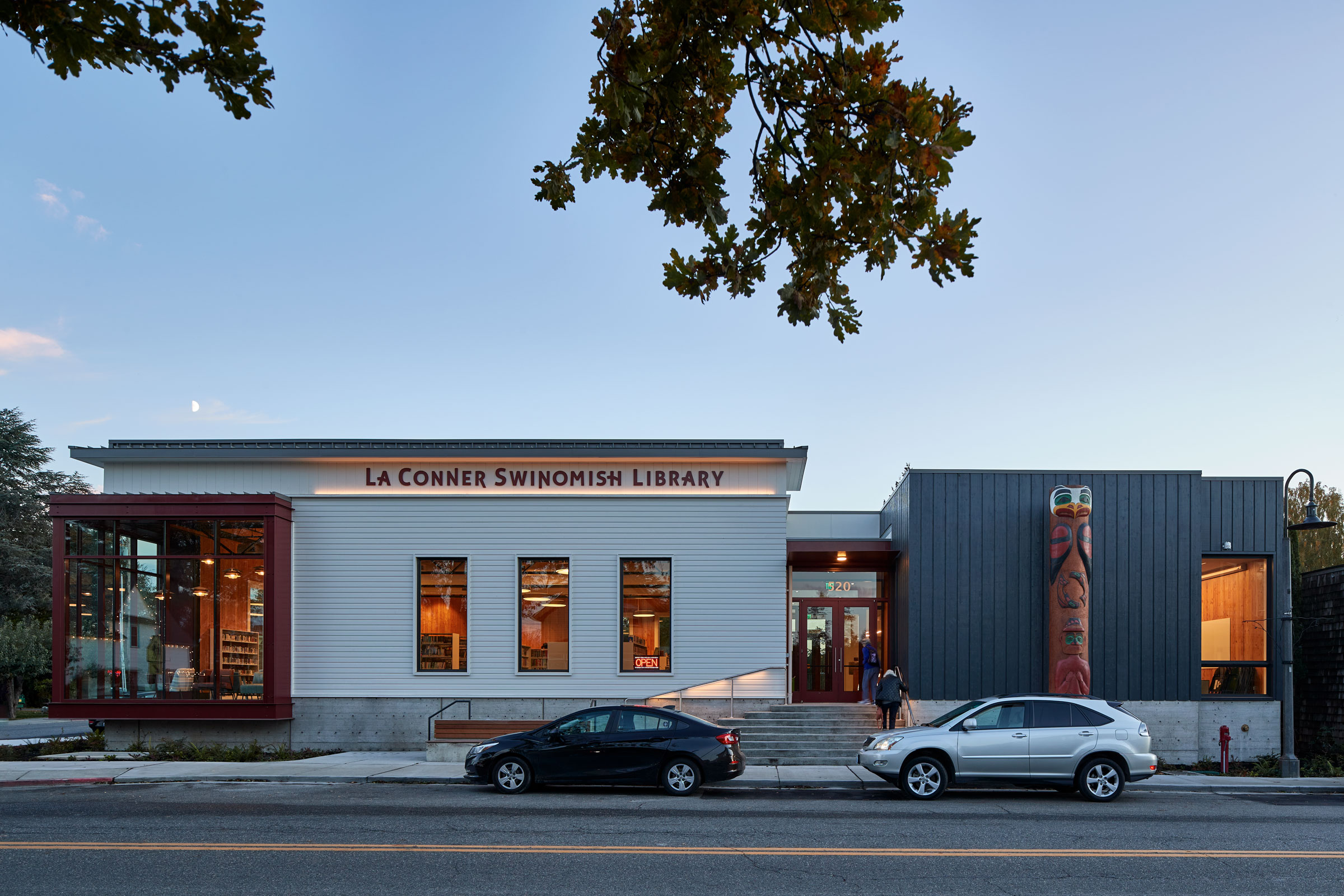
An 18-foot tall cedar story pole was hand-carved with traditional iconography from Coast Salish culture for the front of the La Conner Swinomish Public Library. Photo by Doug Scott
Designed by BuildingWork, the LEED Silver La Conner Swinomish Library honors elements of both Coast Salish culture and the town’s historic past—all through the medium of wood.
The first thing patrons see when they arrive at the library is an 18-foot tall cedar story pole standing just outside the front entrance. Designed by Kevin Paul—a Swinomish elder and master carver—the story pole depicts a traditional Salish person with outstretched hands at its base, two salmon to represent sustenance and resources, and an eagle at its peak to represent wisdom.
When it comes to the building itself, the library’s structural system is constructed almost entirely from locally sourced CLT, most of which was left exposed to help reduce project costs and provide a natural warmth. “We let the mass timber be what it is—the structural element of the whole building and also the interior finish,” Matt Aalfs, founder and principal architect of BuildingWork, previously told gb&d. “It’s a good example of how you can use it on a small budget. Really it’s proof it can be done.”
In addition to the CLT structural system, wood cladding and detailing, along with decorative cornices and vertically proportioned windows, were used to help the building emulate the style of La Conner’s historic 1800s-era architecture. All of the CLT for the project was sourced locally and pre-manufactured in-state, greatly reducing construction times and allowing the entire building to be erected in just three days.
3. Ascent MKE, Milwaukee
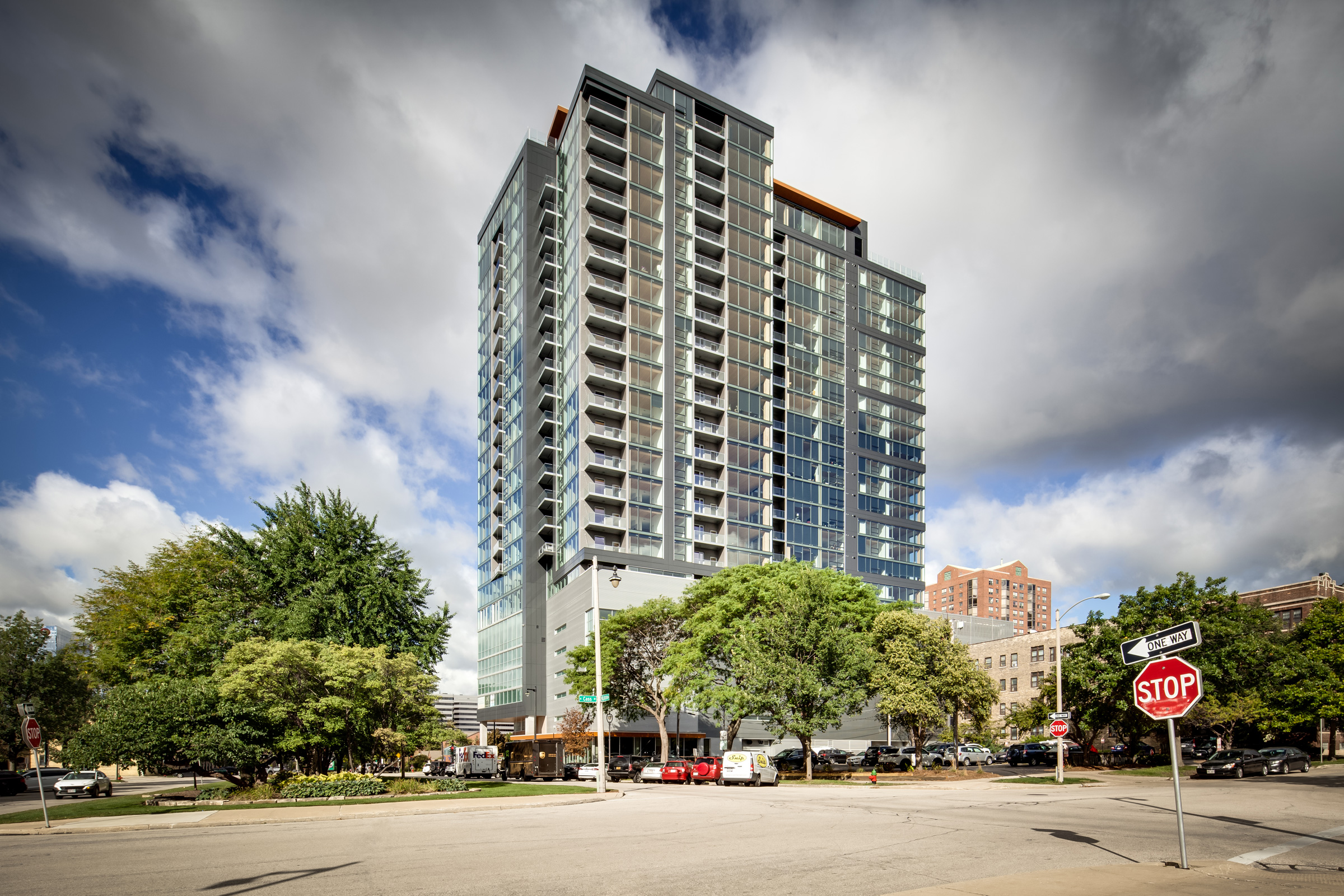
Ascent MKE is the tallest mass timber building in the world and makes extensive use of CLT in its construction. Photo courtesy of Korb + Associates
Designed by Korb + Associates Architects and 284 feet tall, the Ascent MKE building is one of the tallest mass timber buildings in the world.
Aside from the building’s base, stair and elevator shafts—which are all made from concrete—Ascent was constructed primarily from sustainably-sourced glulam beams and columns as well as cross-laminated timber floor panels. Wood used in the interior was largely left exposed as a means of bolstering occupant comfort and as testament to the client’s interest in biophilic design.
Due to its extensive use of mass timber, Ascent MKE is estimated to sequester roughly 7,200 metric tons of CO2. The lightweight nature of wood also resulted in faster construction and reduced waste production.
4. Sara Kulturhus Center, Skellefteå, Sweden

The Sara Kulturhus Center in Sweden is considered to be carbon negative thanks to its extensive use of CLT and glued-laminated timber. Photo by Patrick Degerman
Designed by White Arkitekter, the Sara Kulturhus Centre is built primarily from locally sourced cross-laminated timber and glulam as a nod to the area’s long history of timber construction.
Pre-manufactured CLT modules were stacked between twin elevator cores and supported by a framework of glulam beams and pillars to construct the building’s 20-story high-rise, which houses the Wood Hotel. Similarly the low-rise portion features a timber frame, glulam pillars, and beams as well as shear walls and cores made from CLT. Much of the interior timber is left exposed as a means of showcasing the center’s superb craftsmanship.
According to White Arkitekter’s 50-year life-cycle analysis, the building has a lifespan of at least 100 years and sequesters more carbon than it emits, effectively making the structure carbon negative. The Sara Kulturhus Centre works to preserve Swedish culture through the celebration of art in all its forms and encompasses the City Library, Anna Nordlander Museum, Västerbotten Regional Theatre, and the Skellefteå Art Gallery.
5. Sensations, Strasbourg, France
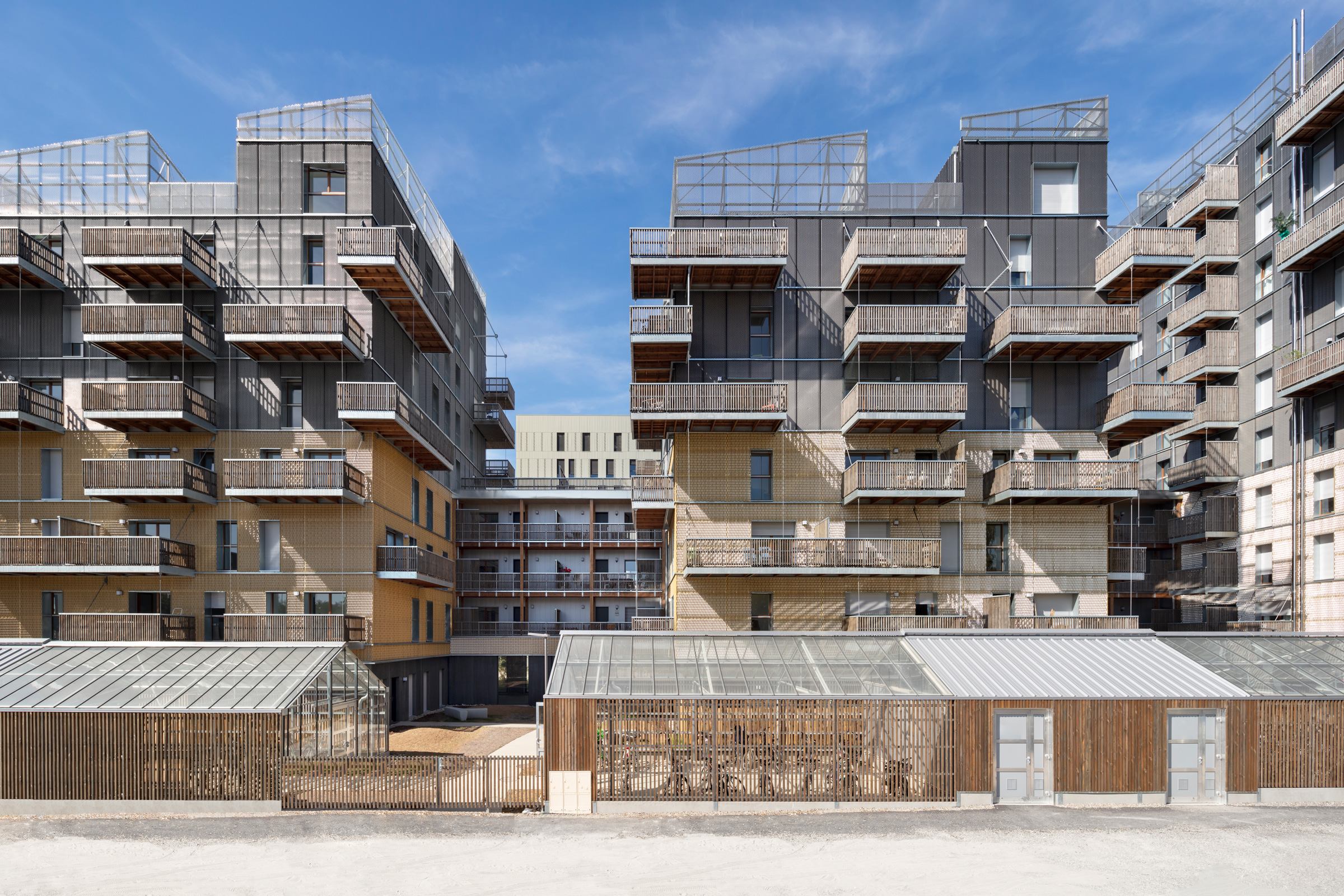
All of Sensations’—the tallest mass timber building in France—load-bearing walls are constructed from CLT. Photo by Septet
In the heart of Strasbourg, designed by KOZ Architectes, the 11-story Sensations residential complex is the country’s tallest mass timber building and was constructed as part of Strasbourg’s “wood block,” which serves to demonstrate how timber may be used to build at height even in urban spaces.
With a frame and envelope composed entirely of wood, Sensations is an inspiring example of how engineered timber may be used in place of high-emission materials like concrete and steel. In fact, the only concrete in the building, used for stairs and the ground floor recovery charges, is there to meet regulation requirements.
From there the majority of the building—including all load-bearing walls—is constructed from CLT and features a glued-laminated beam-to-beam structure. Wood is used for the exterior cladding up to the fourth floor, after which point it transitions into aluminum paneling. In 2020 Sensations received the National Wood Construction Award in the “Living Together” category.
6. Wintringham Primary Academy, St. Neots, England

A cross-laminated timber school building, designed by dRMM Architects, allows students to learn and play indoors and out. Photo by Hufton+Crow Photography
Designed by dRMM and inspired by Forest School principles, Wintringham Primary Academy is a prime example of how CLT may be used to revolutionize sustainable school design. “Wintringham, in a way, should be the minimum requirement for schools, not the exception,” Philip Marsh, a founding director at dRMM, previously told gb&d.
The 32,464-square-foot project is built almost entirely from cross-laminated timber. The school’s extensive use of CLT sequesters an estimated 166 metric tons of carbon, giving it just 49% of the carbon impact of a traditional school. Much of the CLT was left exposed by the dRMM design team to reduce the need for additional finishing materials and provide a biophilic connection to the outside world.
Building with CLT also allowed for much shorter construction times, as the school’s entire frame was able to be erected within a 2.5 month timeframe, greatly reducing the project’s overall cost. Other sustainable features include an energy-efficient building envelope, strategic solar shading solutions, extensive daylighting, natural ventilation, and a flexible floorplan.
7. Mjøstårnet, Brumunddal, Norway
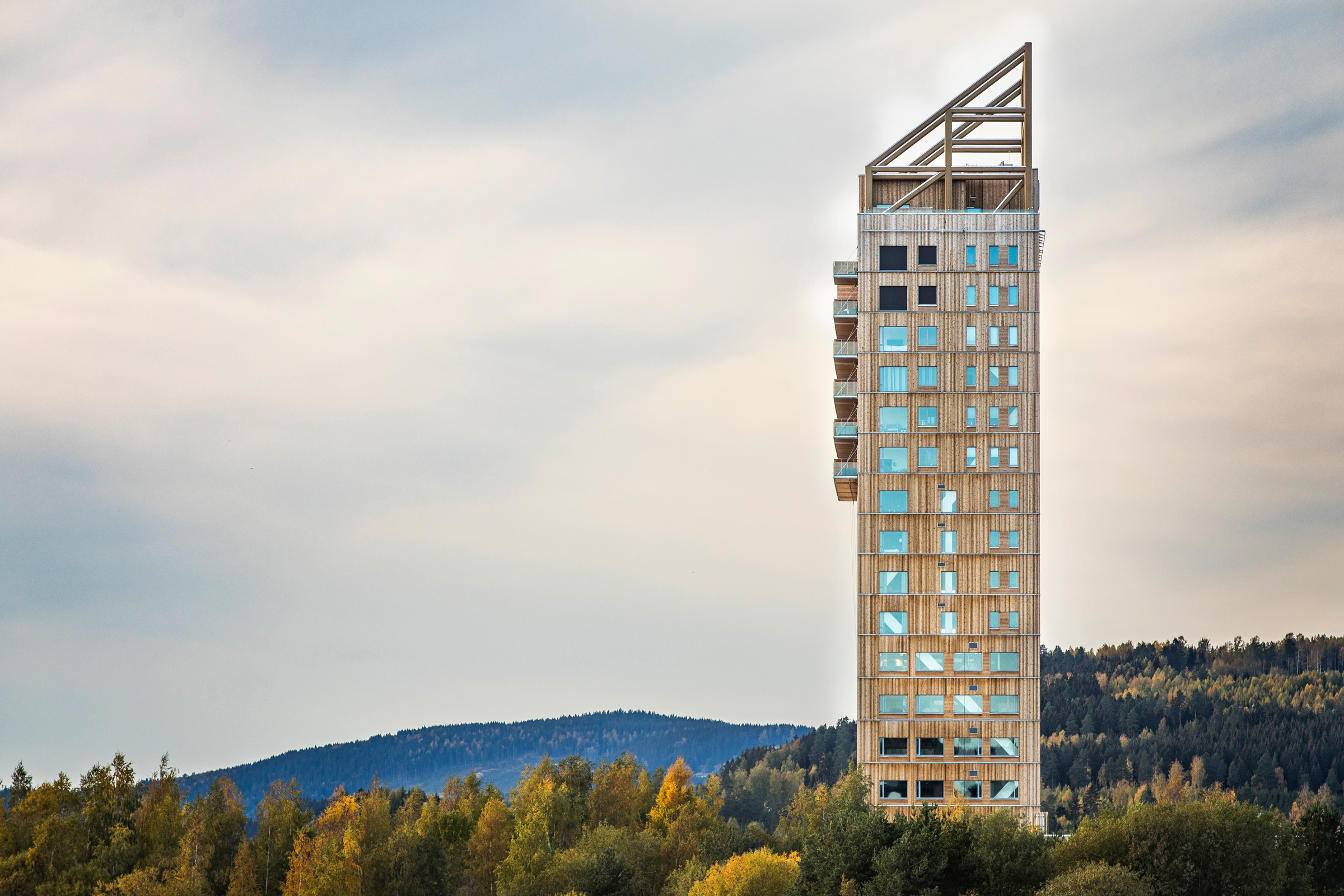
Mjøstårnet is Europe’s tallest mass timber building and makes use of CLT in its balconies, stairwells, and elevator shafts. Photo by Voll Arkitekter + Rikardo Foto
Designed by Voll Arkitekter, Mjøstårnet tower in Brumunddal is Europe’s tallest mass timber building—although when it first opened in 2019, it held the title as the tallest timber building in the world. Mjøstårnet is a mixed-use structure that houses offices, apartments, a restaurant, and even a hotel.
Because all of Mjøstårnet’s main lateral/vertical structural elements and floor-spanning systems are built from wood, the building is considered to be an all-timber structure, even though concrete was used—albeit sparingly—on the building’s top-most floors to meet comfort and acoustic requirements. All in all the tower features approximately 3,500 square meters of mass timber.
CLT was used to construct Mjøstårnet’s stairwells, balconies, and elevator shafts while glued-laminated timber was used for the building’s load-bearing elements. Thanks to the build site’s proximity to a major forestry and wood-processing hub, all of the timber used to construct Mjøstårnet was able to be sourced locally, reducing transportation times and emissions.
8. 55 Southbank Boulevard, Melbourne, Australia
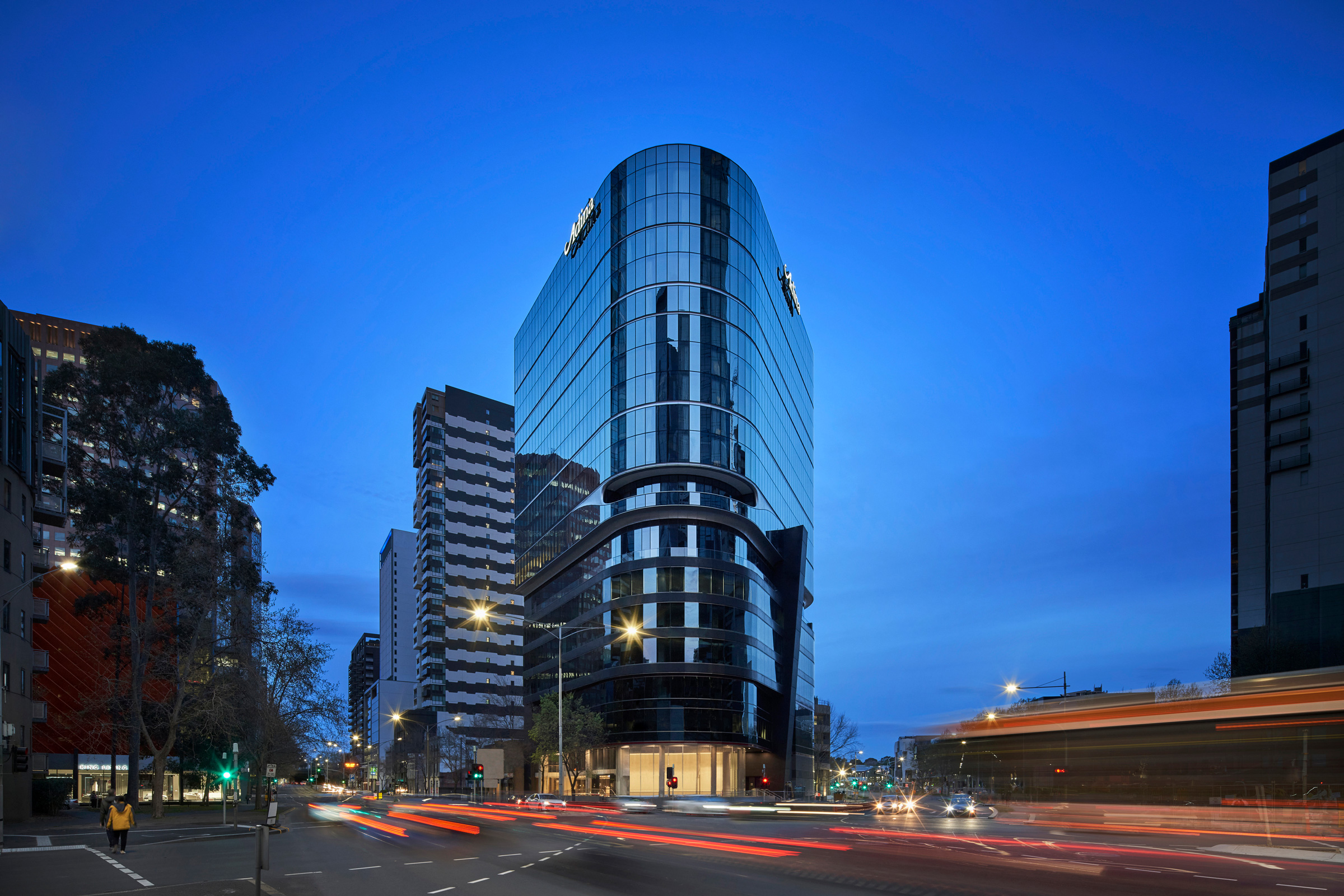
55 Southbank Boulevard is one of Australia’s tallest mass timber buildings and utilizes roughly 5,300 tons of FSC-certified CLT in its construction. Photo by Peter Clarke
Designed by Bates Smart studio, 55 Southbank is one of the world’s tallest vertical mass timber extensions and is Australia’s first CLT extension project. Approximately 5,300 tons of FSC-certified cross-laminated timber was used to construct the extension, resulting in a 4,000 ton offset of atmospheric CO2 emissions—the equivalent to the annual emissions of approximately 130 homes.
Originally built for commercial purposes in 1989, 55 Southbank Boulevard now houses the Adina Apartment Hotel, which boasts 220 rooms and an additional 15,000 square meters of floor space. A total of ten new floors were added on top of the existing concrete-and-steel structure—a feat that would not have been possible without the use of lightweight timber elements, which weigh roughly 80% less than concrete.
The use of CLT also meant that a large portion of the extension could be prefabricated off-site, resulting in shorter construction times and a reduced impact on surrounding buildings.
9. Waratah, Bella Vista, Australia

Waratah features approximately 2,700 square meters of CLT, all of which was sourced from BinderHolz, an Austrian CLT provider that takes a no-waste approach to its manufacturing process. Photo by Brett Boardman
The Jackson Teece-designed 10-story Waratah is one of several buildings comprising the Aveo at Bella Vista senior living development and is the only one to feature a cross-laminated timber structure.
Constructed from approximately 2,700 square meters of ethically sourced cross-laminated timber, Waratah is one of the tallest mass timber buildings in Australia and was awarded the Australian Timber Design Award for Sustainability in 2018. In addition to CLT, glulam columns were also used to support large glazing elements in the building’s main lobby, with timber left exposed throughout most of the interior.
Jackson Teece sourced all of the wood used in Waratah’s construction from Austrian CLT provider BinderHolz, whose production sites meet and are certified under rigid PEFC standards. The company prioritizes sustainability at every turn and utilizes a no-waste manufacturing process that ensures 100% of every logged tree—including bark, wood chips, sawdust and shavings—is used in some manner.
10. McDonalds’ Chicago Flagship
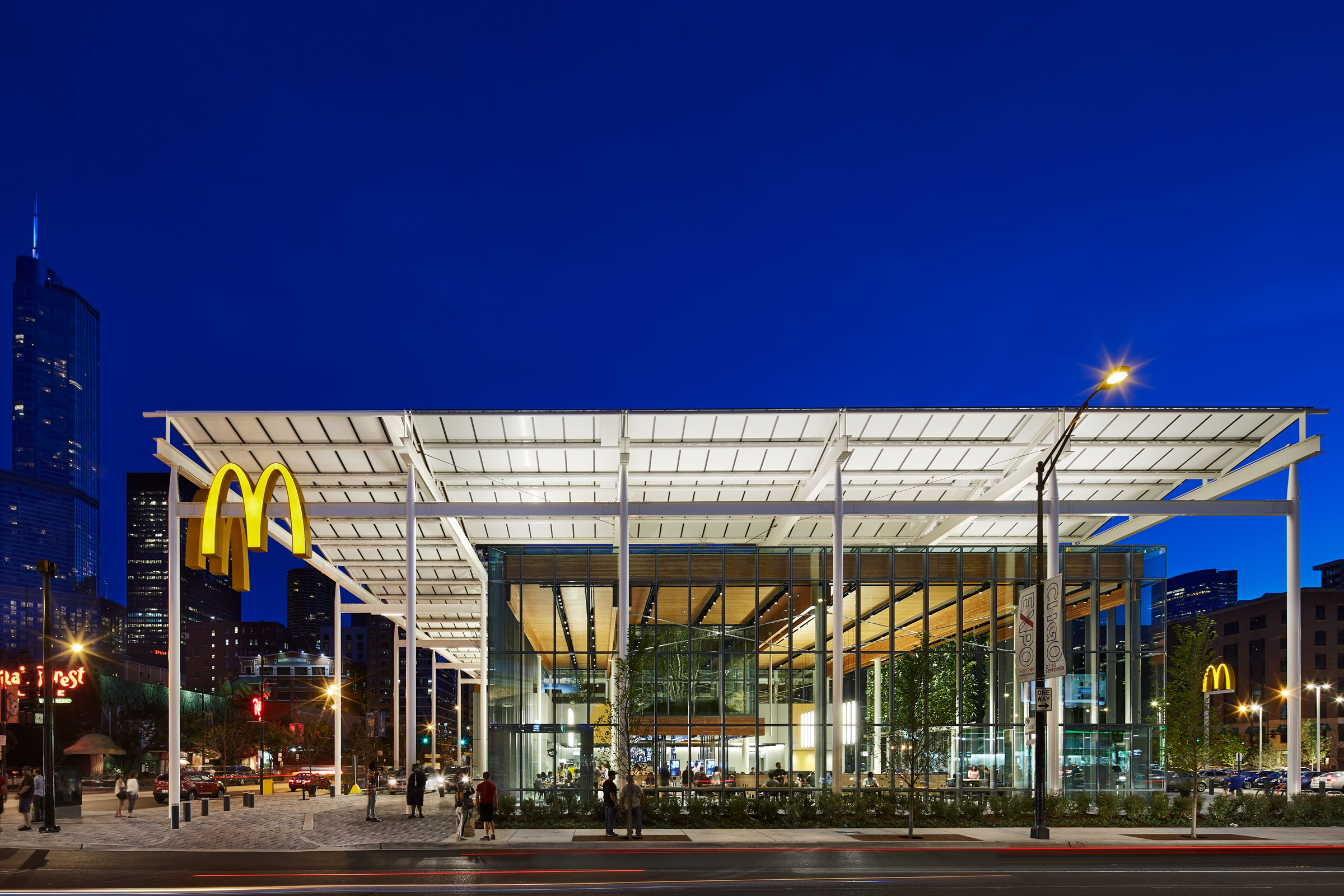
McDonald’s flagship restaurant in Chicago was designed by Ross Barney Architects. Photo by Kendall McCaugherty, Hall+Merrick Photographers
While the golden arches typically don’t bring to mind timber construction, McDonalds’ Chicago Flagship location represents the company’s first foray into the world of mass timber architecture.
Designed by Ross Barney Architects, the Chicago Flagship utilizes a cross-laminated timber structural system—the first commercial project in Chicago to do so—as well as glulam structural elements. The carbon sequestered and saved by this CLT is equivalent to removing more than 34,000 passenger vehicles from the road for one year.
In addition to the use of CLT, the project boasts a slew of other sustainable features, including green roofs, solar panels, permeable pavement, interior plants, daylighting, and more—all of which helped the Chicago Flagship earn LEED certification.
11. Timber Lofts, Milwaukee
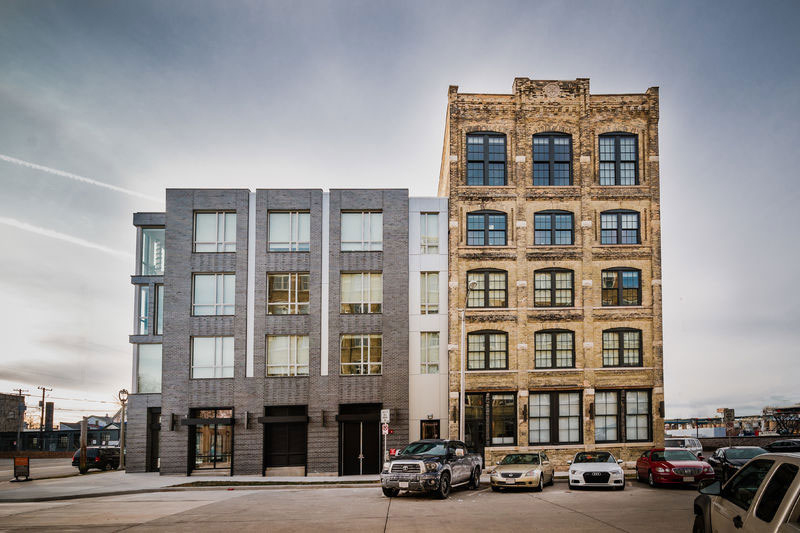
Milwaukee’s first mass timber building harmonizes a neighborhood’s history with renovation through the addition of CLT to the original hardwood flooring. Photo by Roost Photography, courtesy of Engberg Anderson
Timber Lofts—a five-story, 60-unit multi-family complex and 2021 Wood Design Awards winner—is the first mass timber building in Milwaukee. As an adaptive reuse project, the complex with ground-floor retail is a direct reflection of its historic yet trendsetting locale.
“The idea from the onset was to harmonize the existing building with new construction,” Tim Wolosz, principal at Engberg Anderson, told gb&dPRO member Think Wood. “The [developer and contractor] wanted to use cross-laminated timber, and I was thrilled. We were excited about the technology of mass timber and the opportunities it could provide.”
A defining characteristic of the renovation is the preservation of original wood flooring. Individual boards were meticulously deconstructed, stacked, and set aside for cleaning and sandblasting to remove paint, exposing the wood’s maple grain. After subflooring and sound control materials were added, the original wood floor was reinstalled.
After the Timber Lofts project’s completion in Spring 2020, residential units were 90% leased six months after opening, and retail leasing is expected to increase after the pandemic.
12. 69 A Street, Boston

Architecture firm Margulies Perruzzi used CLT to add two floors to an existing brick building in Boston. Photo courtesy of Margulies Perruzzi
Margulies Perruzzi, one of New England’s most innovative architectural and interior design firms, added two stories to an existing 1920s-era brick and beam building by using CLT.
The building at 69 A Street in South Boston was originally designed for industrial use with three floors. The design team at Margulies Perruzzi selected CLT for their construction, as it aligns with the industrial brick and beam nature of the building.
CLT offers new possibilities in wood construction due to its superior strength and stability. Nordic Structures, a company dedicated to engineered wood products in the construction industry, says wood is five times lighter than concrete and 15 times lighter than steel. This allows teams like the one at Margulies Perruzzi to retain the existing structure without replacing or reinforcing the existing foundations. The team left the CLT exposed on the upper floors, creating a much more warm exterior than standard steel.
13. Sideyard, Portland, OR
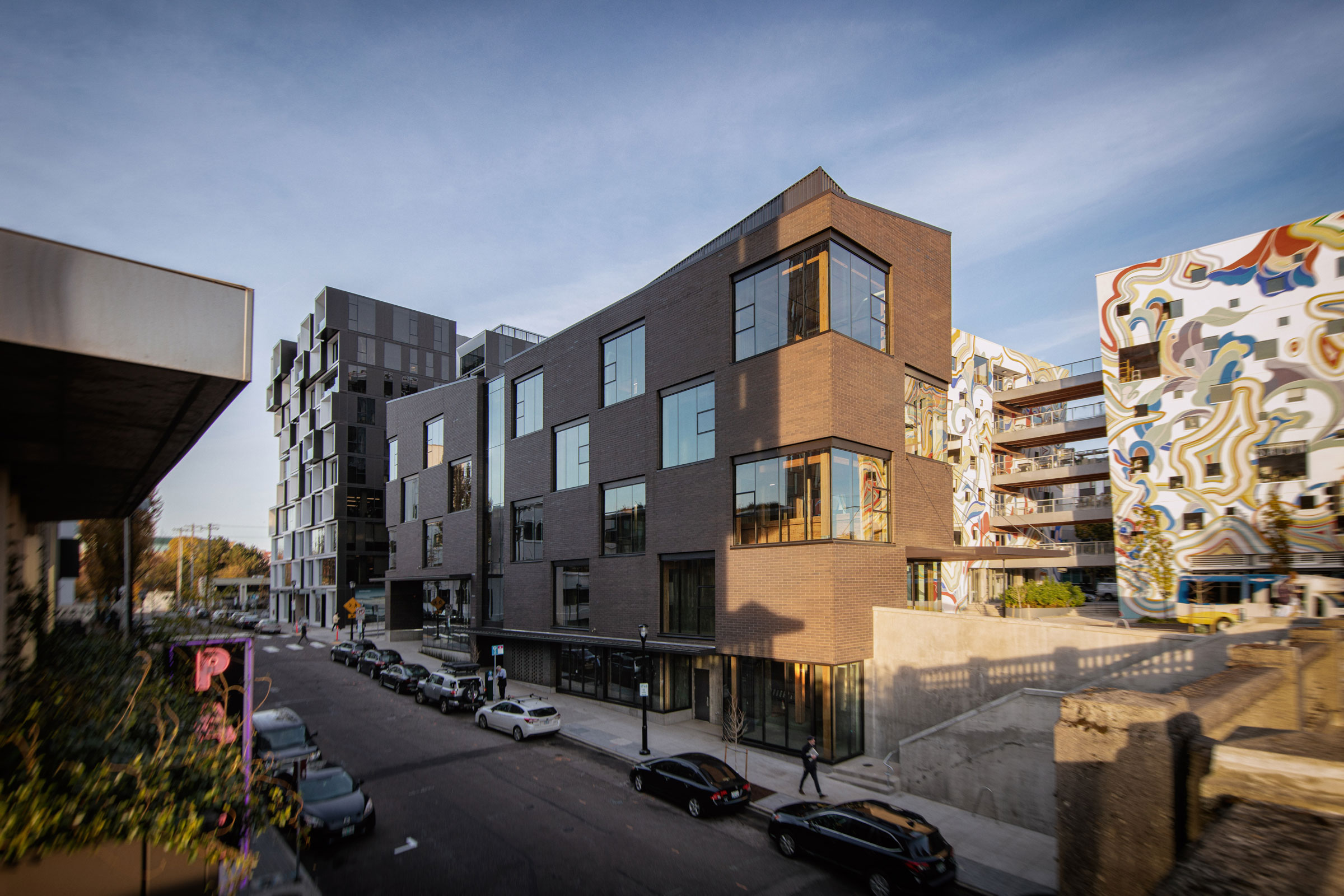
Skylab’s Sideyard project in Portland, Oregon, is a commuter-accessible building tailored to the working class. Photo by Stephen Miller
Sideyard emerged from an empty 9,000-square-foot berm to form a gateway between Portland’s urban core and the city’s Eastside. With a focus on commuter accessibility, Sideyard provides retail on the ground floor along Third Avenue and open floor plans above that provide adaptable office and workspace.
“The goal was to provide a noble stage for community activity and future public/private uses. Creating a series of comfortable and inspiring spaces simply framed with a palette of masonry, wood, glass, and concrete,” Jill Asselineau, project director with Skylab, said in a release.
A prominent material used was CLT, particularly inside the building. General contractor Anderson Construction championed the timber for its regional relevance, availability, and simplicity of assembly. It minimizes onsite construction waste and offers high seismic and thermal performance.
Most of the space’s visitors are commuters, considering it is located on the corner of a popular bicycle commuter route. The openness of the communal space promises adaptability to suit the neighborhood’s needs over time.
14. Andy Quattlebaum Outdoor Recreation Center at Clemson University, SC
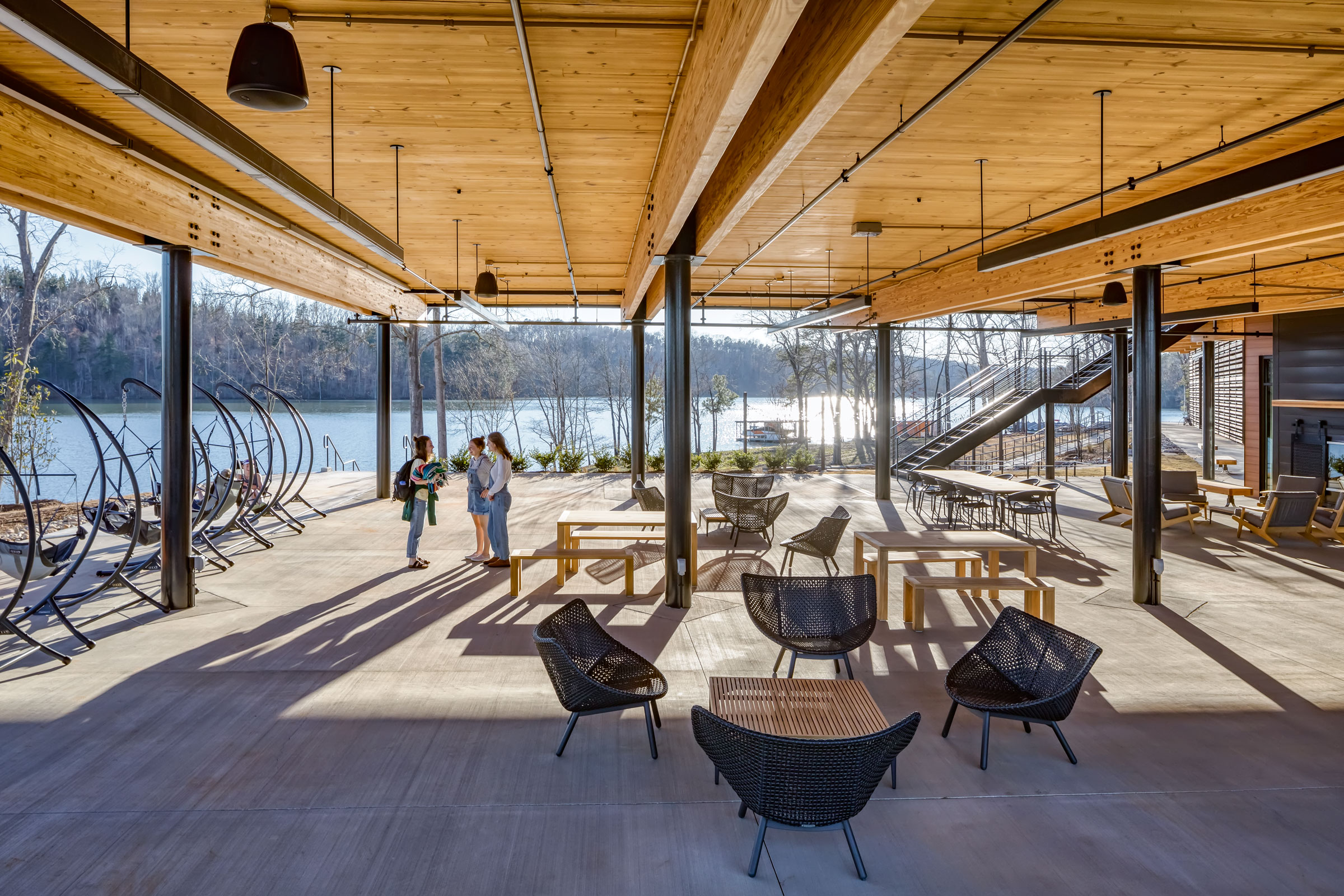
The Andy Quattlebaum Outdoor Recreation Center at Clemson University boasts exposed timber throughout the indoor-outdoor building. Photo by Jonathan Hillyer
A combination of beautiful local nature and mass timber construction brings the Andy Quattlebaum Outdoor Recreation Center at Clemson University to life as the university’s first mass timber structure.
Students’ mental and physical health was at the heart of this project by architecture firm Cooper Carry. The firm collaborated with Clemson University’s Wood Utilization + Design Institute on the project. “As advocates for sustainable, wood-based architectural design, the team was armed with a breadth of research to help inspire the Clemson leadership community to have an open mind to this level of innovation,” Brian Campa, principal at Cooper Carry, told gb&d in a previous interview.
Cooper Carry used CLT slabs for the floors and roof structure. According to Campa, CLT offers significant sustainable advantages, including a lower carbon footprint. “The material is lauded for its ability to achieve long spans. This was one reason the cost of the material was competitive.”
Exposed timber throughout the building, coupled with expansive views of the lake and tree canopies, supports student engagement with nature.
15. Dalston Works, London
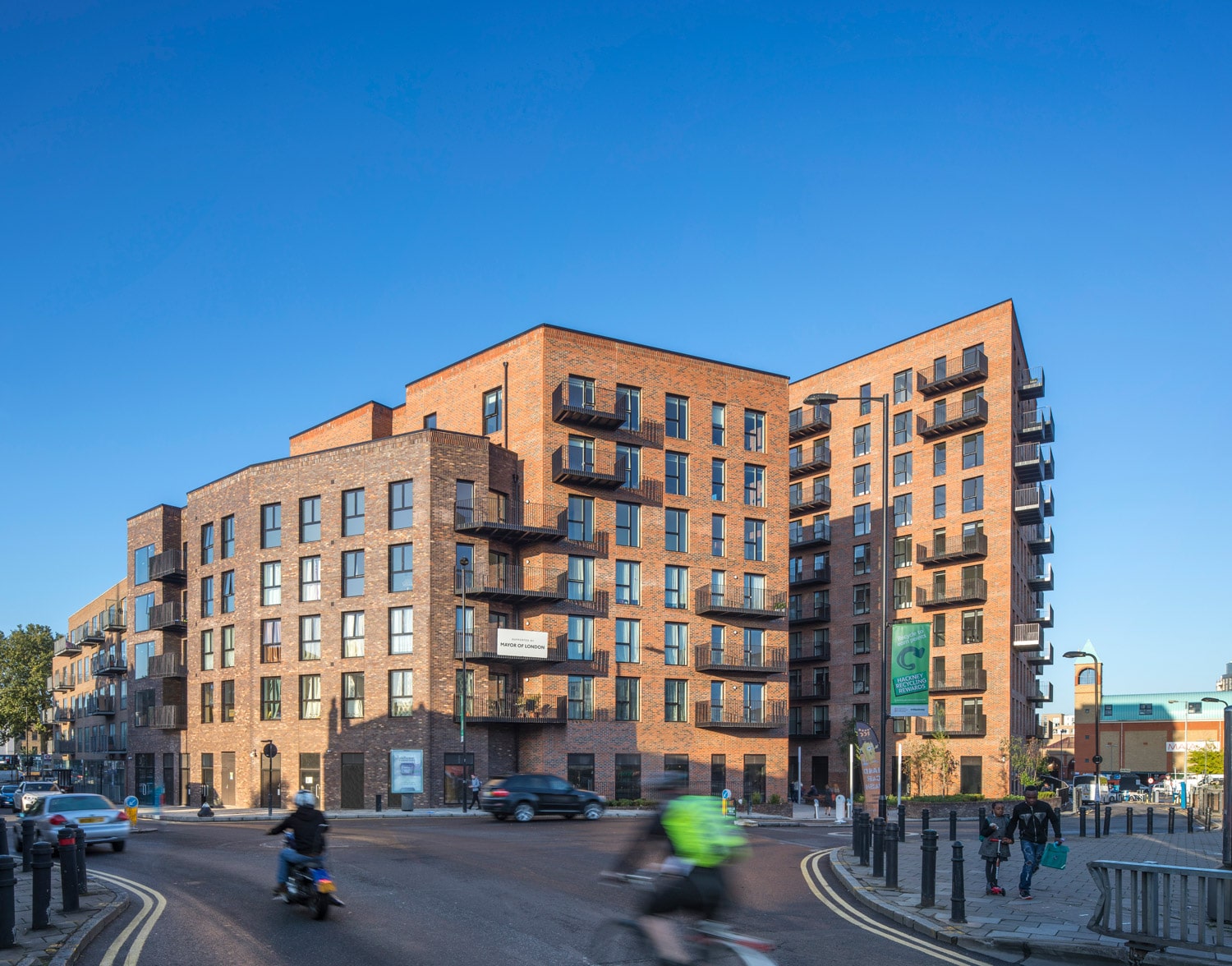
Dalston Works is one of the world’s largest CLT buildings, featuring 10 stories and 121 residential units. Photo by Daniel Shearing
Dalston Works in London is built almost entirely of CLT, reducing the building’s carbon footprint in both material production and onsite energy consumption. However, the 10-story, 121-unit residential building designed by Waugh Thistleton Architects doesn’t even appear to be made of CLT. The outside of the building—done in clad brick with steel balconies—was designed to fit in with other buildings in the neighborhood.
When constructing Dalston Works, all CLT components—including floors, walls, stairs, and shafts—were prefabricated and then transported to the construction site. Prefabrication meant less noise and dust onsite, along with less waste and onsite deliveries—which were reduced by an estimated 80%, according to Andrew Waugh, partner at Waugh Thistleton Architects and lead architect on the Dalston Works project.
“Architecture is about humanity. It is about far more than choosing the color of the windows. It is about understanding the implications of your actions as an architect,” Waugh previously told gb&d. “The production of concrete and steel are responsible for 18% of the greenhouse gases in the world. It’s about fulfilling your professional role as an architect and refusing to be marginalized.”
16. The Ecology School, Saco River, Maine

The Ecology School by Kaplan Thompson Architects contains wall panels from a local white pine company. Photo courtesy of Kaplan Thompson Architects
The Ecology School—a nonprofit ecology education center for students of all ages—is on a historic 105-acre farm on the Saco River in Maine.
The Ecology School, designed by Kaplan Thompson Architects, is made of low-embodied energy materials, including Forest Stewardship Council-wood. The FSC wall panels came from Hancock Lumber, a local white pine company that harvests from their own timber land and manufactures their own wood products.
The school was designed to achieve the Living Building Challenge 3.1 certification. The goal is to create design solutions that actually improve the local environment rather than simply reducing harm. The building will have more than 700 solar panels onsite to support the goal of producing 105% net positive energy.
“Rising to the Living Building Challenge and asking for spaces to give more than they take from the environment around them is a ‘live what you learn’ experience,” Caitlin Brooke, marketing manager at The Ecology School, previously told gb&d. “You become a living example of how all systems in our world are connected and how daily living can have a positive impact on our environmental health, not a drain.”
17. FABRIC, Reykjavik
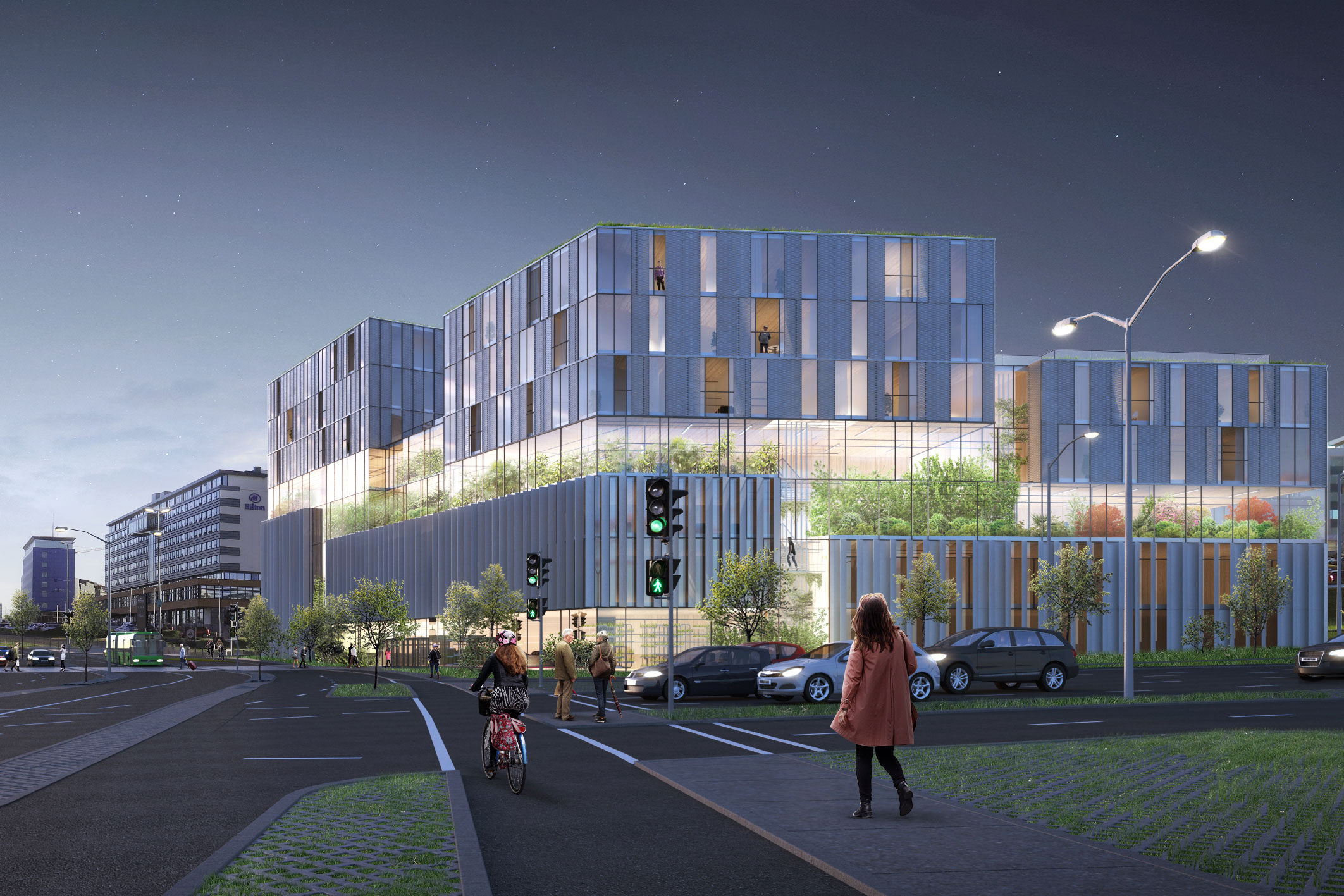
Basalt Architects designed FABRIC, an ongoing project in Reykjavik that uses low-carbon construction materials. FABRIC incentivizes alternative and communal ways of living and working—mixing housing, office space, public space, service, and retail. Photo courtesy of Basalt
Well-known Icelandic firm Basalt has been at work on a project called FABRIC since 2017. FABRIC is an eight-story building complex that is deeply rooted in the city’s shift toward co-living and co-working. Located on the direct route of the new city bus line, FABRIC will soon be home to shared and private co-living spaces, co-working offices, urban farming, retail, a bike shed, and more.
Beyond using geothermal energy like many other Icelandic buildings, the design team at Basalt chose to build with CLT due to its design flexibility and low environmental impact.
“It’s a really active hub—not only the building itself but also how it channels the city through it,” Marcos Zotes, partner at Basalt Architects, said in a previous gb&d interview. “It should promote a healthier way of living. The aim is to have services that reflect this—medical offices, psychology offices, et cetera.”
18. The Environmental Nature Center and Preschool, Newport Beach, California
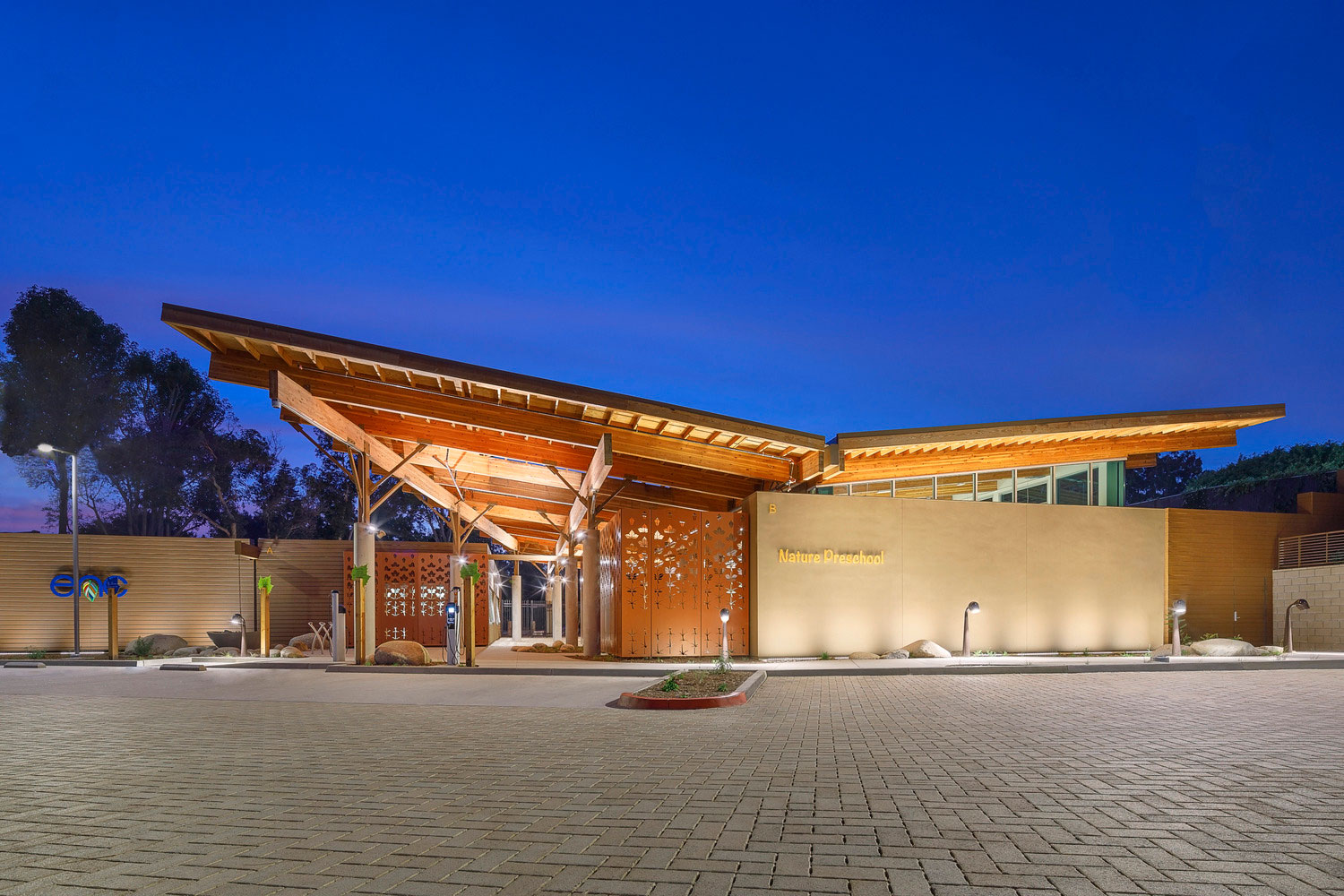
The new 8,000-square-foot, three-classroom Environmental Nature Center (ENC) Preschool is the second LEED Platinum Net Zero building on ENC’s 4.7-acre campus in Newport Beach. Photo by Cris Costea Photography
The Environmental Nature Center and Preschool in Newport Beach, California is the region’s first LEED Platinum building.
The building designed by LPA Design Studios features timber FSC-certified wood as the primary building material. The timber in the primary structure and framing system offers a longer life cycle.
The single-story wood frame preschool has been operating net positive since 2008, generating 60% more energy than it’s using. No natural gas is used in the building, and PV panels supply 100% of the school’s power.
19. Yellowstone National Park Youth Campus, Wyoming
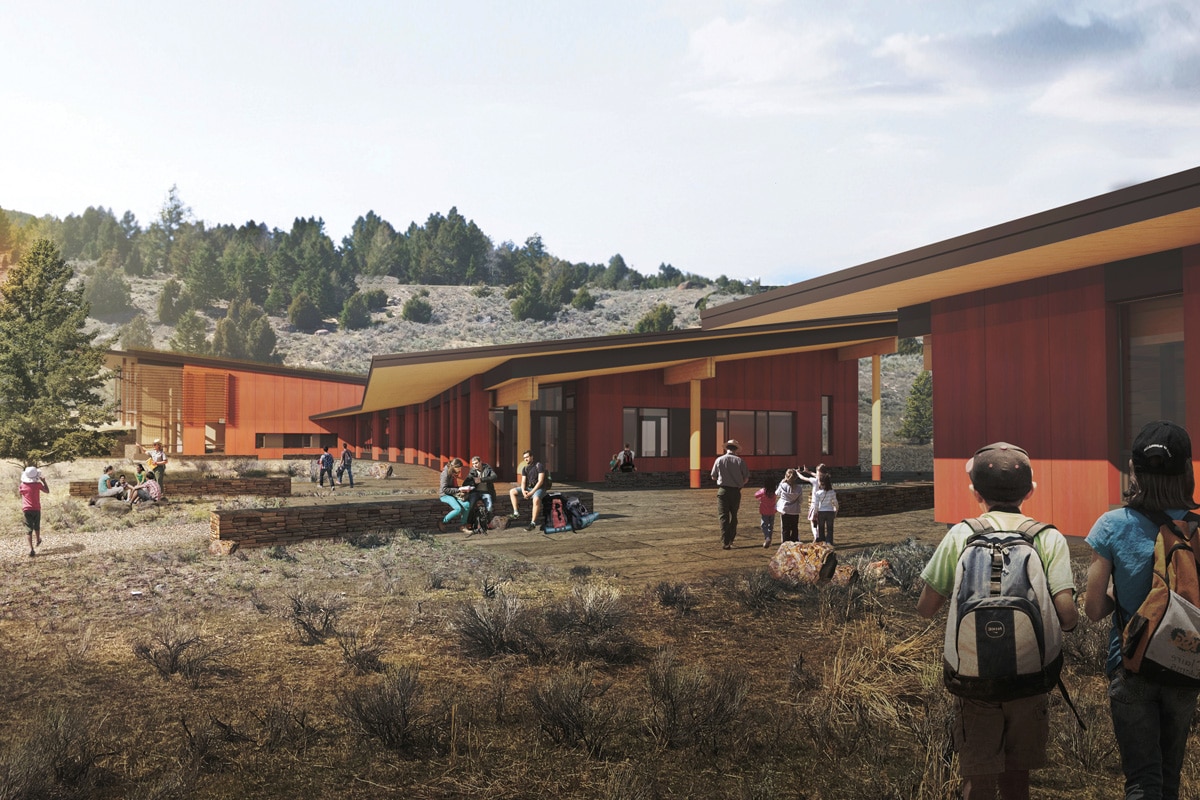
Hennebery Eddy Architects plans on using CLT construction throughout the Yellowstone National Park Youth Campus. Rendering courtesy of Hennebery Eddy Architects
Although not yet completed, the Yellowstone National Park Youth Campus is targeting 115% net positive energy and designing to Passive House standards.
The building by Hennebery Eddy Architects uses hydronic radiant heat in the floor and heat recovery ventilators. The team also plans on using CLT not only for practical reasons, but aesthetics too.
“We’re exposing a lot of the interior wood timber and CLT construction throughout to keep the material palette really clean and natural,” Camilla Cok, member of Hennebery Eddy Architects’ sustainability committee, told gb&d in a previous interview. “Then we’re bringing natural daylight in and providing views out to the natural landscape.”
20. Platte 15, Denver
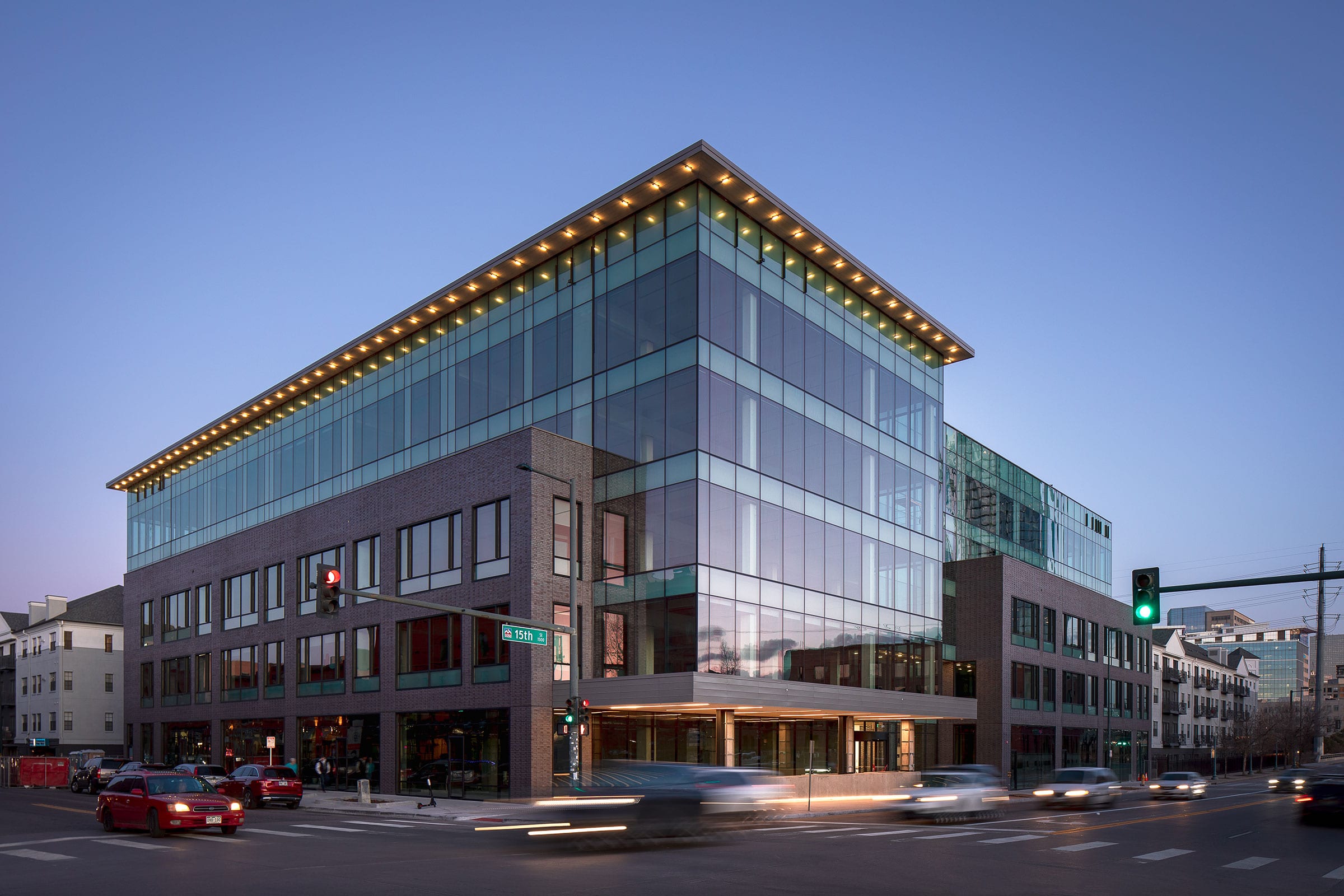
Platte 15, Denver’s first CLT building, is estimated to achieve a potential carbon benefit of 5,580 metric tons by using CLT as a building material. Photo by JC Buck
Platte 15, a five-story retail and office space, is Denver’s first CLT building. The development team behind Platte 15 was drawn to use CLT because of its sustainable, insulating and cost-effective properties.
“This building will store 1,790 metric tons of carbon dioxide within the wood. Another 3,800 metric tons of carbon dioxide greenhouse gas emissions will be avoided for a total potential carbon benefit of 5,580 metric tons,” Conrad Suszynski, co-CEO of Crescent Real Estate, previously told gb&d. “We have proven wood is a cost-viable, sustainable structural option with regenerative benefits for mid-rise commercial construction. That’s a genuine evolution, and that’s a big deal.”
Timber is an insulator, as compared to steel and concrete, which are thermally conductive. Buildings built with mass timber require less energy to heat, cool, and maintain temperature. CLT’s lighter weight also saves money and waste, as it makes the material easier to transport after production.
Samantha Stevens contributed to this article.

